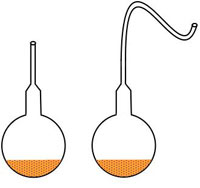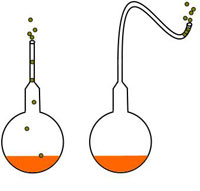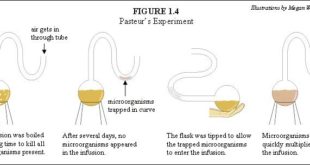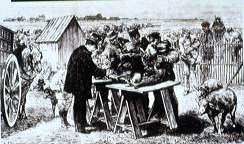The steps of the Louis Pasteur Experiment proving the existence of microbes are outlined below:
- In the first step of the Louis Pasteur experiment, he prepared a nutrient broth similar to the broth one would use in soup.
- Next, he placed equal amounts of the broth into two long-necked flasks. He left one flask with a straight neck. The other he bent to form an “S” shape.
Images courtesy William Harris - Then he boiled the broth in each flask to kill any living matter in the liquid. The sterile broths were then left to sit, at room temperature and exposed to the air, in their open-mouthed flasks.
- After several weeks, Pasteur observed that the broth in the straight-neck flask was discolored and cloudy, while the broth in the curved-neck flask had not changed.
- He concluded that germs in the air were able to fall unobstructed down the straight-necked flask and contaminate the broth. The other flask, however, trapped germs in its curved neck, preventing them from reaching the broth, which never changed color or became cloudy.
- If spontaneous generation had been a real phenomenon, Pasteur argued, the broth in the curved-neck flask would have eventually become reinfected because the germs would have spontaneously generated. But the curved-neck flask never became infected, indicating that the germs could only come from other germs.This Louis Pasteur experiment proved the existence of microbes and disproved the theory of spontaneous generation.
 Pasteur Brewing Louis Pasteur – Science, Health, and Brewing
Pasteur Brewing Louis Pasteur – Science, Health, and Brewing 






